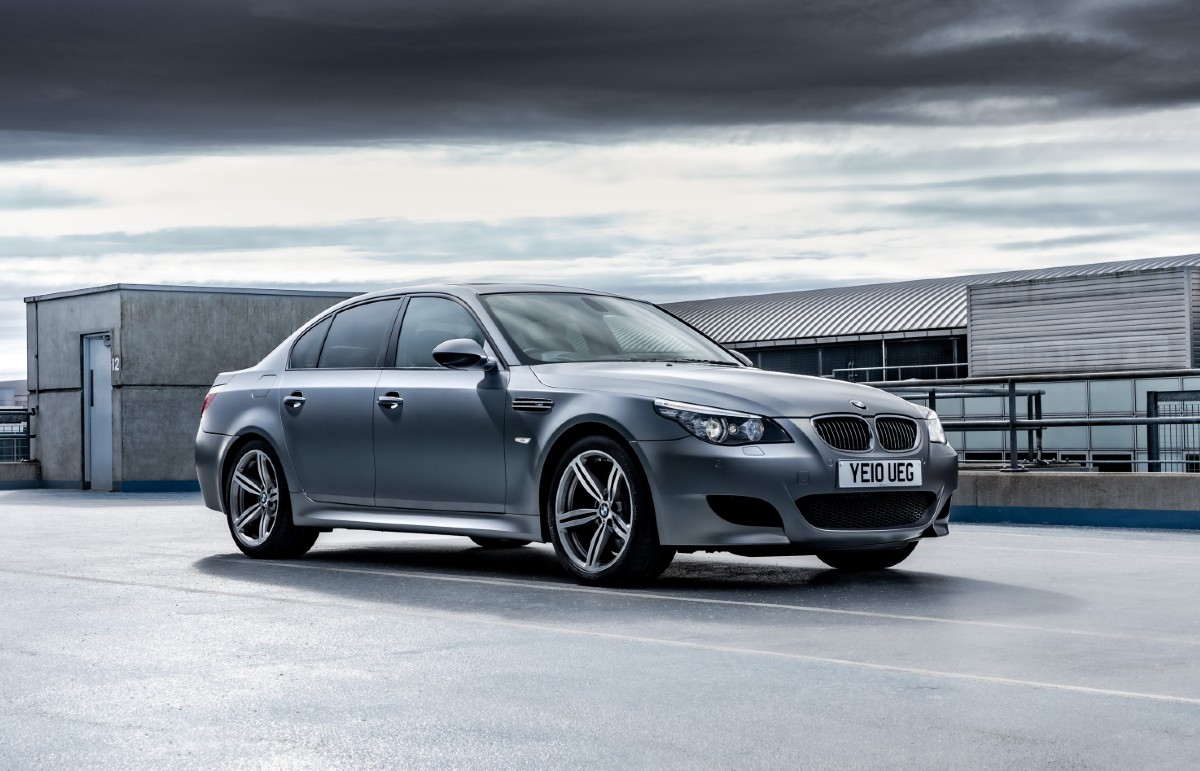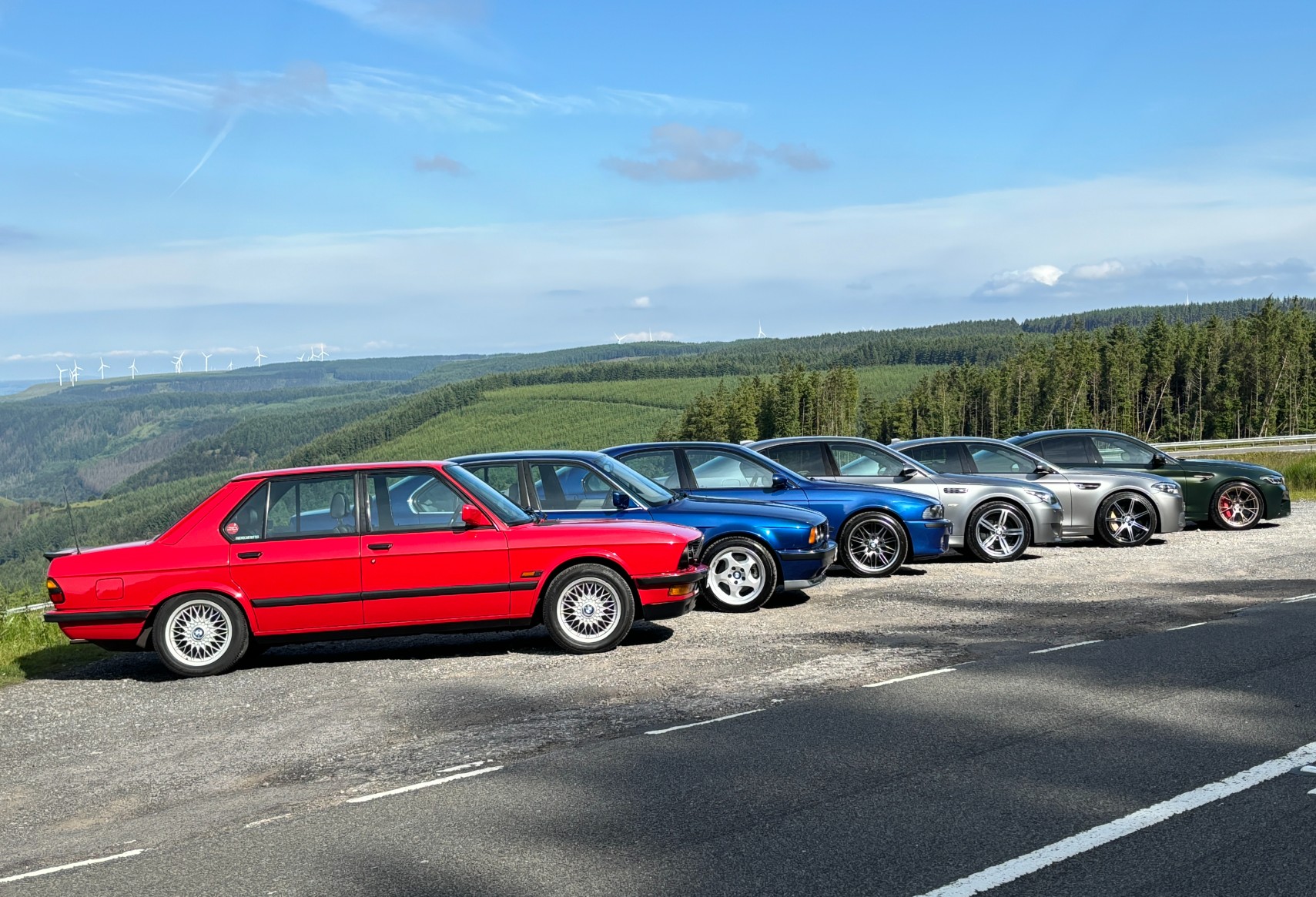Blast from the Past
Blast from the Past: Pop a brave pill for the BMW M5 E60

An auction on PistonHeads caught my eye recently. It was for a BMW M5, the E60 V10 version that instils fire in the heart and fear in the belly of every car enthusiast, and really is one of those cars that deserves a place on the must-drive bucket list.
When they were current, I was working for a car magazine and we took the E60 M5 to Liverpool, along with a Maserati Quattroporte and Mercedes CLS55 AMG. The three cars had character and appeal to spare – you’d have been happy to drive home in any of them – and during the night shoot we’d planned they looked subtly menacing down by the docks. But it wasn’t until the next day, when we’d escaped the confines of the city and taken to some country roads, that everything changed.
The M5 was the only car to really and truly come alive and encourage the driver to keep pushing. The Quattroporte went all wobbly on you, and the CLS55 AMG was bonkers-fast but flat-footed. Later, we took an E60 M5 to Bruntingthorpe airfield. The howling, yowling V10 made it a certifiable lunatic of a super saloon.
During the day, heavy rain stopped our photoshoot. So myself and three colleagues spent most of the afternoon drifting around the airfield at silly speeds and increasingly silly angles, until one of them lost it at about 80mph and we had a near-miss, sliding back over the grass and passing a brick-built outbuilding with a wing-mirror’s width to spare.
That’s the thing about a car like the E60. It encourages you to be naughty, and – most of the time – rewards you for it. The sound of that V10 emanating from something as visually ordinary as a 5-series saloon is deliciously wicked, and in some ways it was true to the spirit of the original E28 M5, launched 40 years ago.

Driving an original E28 M5 today is an eye-opener; it is a hot rod of a car that feels every inch the Motorsport project that it was. At the end of the previous decade, we’d had a hint of what was to come, after BMW Motorsport crafted 1979’s M535i. It was the first production series M car, and I vividly remember a family friend in Belgium owning one and blowing everything on the road into the weeds, as we ripped along the autoroutes on the way to the Belgian Grand Prix, accompanied by the distinctive, bassy rasp of that straight-six motor.
The M5’s M88/3 straight-six was essentially lifted from the mid-engined M1 sports car (a car with a fascinating backstory I have written about here) and dropped into the nose of the E28 saloon. In those days, it was very much a hand-built car, assembled in Preussenstrasse, Munich, initially and, from the summer of ’86, in Daimlerstrasse in Garching, where the remainder were also built by hand.
The second-generation E34, arriving in 1988, was the moment BMW truly perfected the formula. Its S38 straight-six was smoother, stronger and less temperamental, the chassis more resolved, the build quality vault-like. It was also the last M5 to be assembled largely by hand, and it shows. There’s a mechanical purity to an E34 that feels timeless – a precision instrument rather than a plaything.
Then came the E39, the first M5 to adopt a V8. Launched in 1998, it marked a cultural shift: this was a car built for the autobahn, not the racetrack. It was devastatingly capable and wonderfully subtle, but you could sense the weight of technology beginning to creep in. It was smoother, quieter, more sophisticated, but the recirculating-ball steering rack let it down.
And then, in 2005, the E60 M5 landed like a thunderclap. Beneath its unassuming 5 Series bodywork sat a 5-litre V10 engine derived directly from BMW’s Formula One programme. No turbos, no hybrid assist, no tricks. Just 10 cylinders, 507bhp, and a red line so high – 8250rpm – that the rev counter had to wrap around the dial to contain it. The gearbox was an automated manual known as SMG III – Sequential Manual Gearbox – which changed gear with a brutality that left no doubt about the car’s intentions.
.jpg)
From the outside, it didn’t shout about any of this. A pair of dual tailpipes, some subtly flared arches, and discreet M badges were the only clues. But inside, it was new and shiny. The E60 greeted you with an engine start button – a novelty in its day – and a complex series of settings that could transform its personality: power modes, gearbox response, suspension stiffness. It was new and exciting, and because it was new it was all under warranty, so the fear of something glitching or detonating was nothing like as profound as it is today.
Driving one after all those years is still an event. That V10 is a masterpiece of theatre and drama, up there with the CSL’s S54 straight-six for harmonic harmony. Below 4000rpm it’s civilised, almost docile with an off-beat burble; above 5000rpm it explodes, howling with a note that melds metallic precision and unhinged lunacy in equal measure. The seven-speed SMG III gearbox, much maligned in period for its jerkiness, now feels part of the experience – an unfiltered mechanical handshake between driver and machine. You have to work with it, time your shifts, commit. Do that, and the car feels alive in a way few performance saloons ever will.
And then there’s the chassis. It looks like a large, top-heavy saloon car, right? Yet it feels compact, agile and eager to dive into corners, and there’s unfiltered feel through the seat of your pants and the steering that encourages you to switch off the stability control and trust your instincts. Then you’ll find it’s balanced and predictable, and very, very good at slides…
Development of the E60 was overseen by Albert Biermann and the engineers at BMW M GmbH in Garching. The engine, codenamed S85, shared architecture with BMW’s F1 V10 of the era – a 90-degree block, with individual throttle bodies and a dry-sump lubrication system allowing sustained high-G cornering. The gearbox was the same basic unit fitted to the contemporary M6, and the suspension was uniquely tuned: double-wishbone front, multi-link rear, with electronically adjustable dampers. In 2005, this was good shit.
Between 2005 and 2010, BMW built around 20,500 E60 M5s worldwide, of which just over 1000 were officially sold in the UK. The cars were offered initially only with the SMG transmission, though late in production – from 2007 in North America and later for certain markets – BMW relented and added a six-speed manual option. UK buyers, however, never officially received that version.
When new, the E60 cost just under £62,000, though with options many crept closer to £70,000 – about the same as a well-specified Porsche 911 Carrera of the time. Early cars were notorious for eye-watering running costs; fuel and oil consumption, rod bearing wear and the SMG pump were common pain points. It wasn’t a car for the faint-hearted, then or now.
.jpg)
Yet the pay-off remains immense. The E60 is one of the last truly analogue M cars: no turbochargers, no torque vectoring, no switchable all-wheel drive. Find a clear stretch of road, pin the throttle, and there’s a moment at around 7000rpm when the V10 goes from a hard-edged snarl to a scream that makes every hair on your neck stand up and you remember what it is about driving that gets you out of bed before the sun’s up.
In today’s market, the E60 has gone from misunderstood to mythic. Browse The Classic Valuer, via this link, and you can seen how Prices dipped below £15,000 a decade ago, and more than a few ended up neglected or broken for parts. But some enthusiasts are starting to be brave and set these special saloons aside. The best low-mileage UK cars now command £30,000–£40,000, and exceptional examples with BMW history can nudge £50,000. The rare Touring version – only 208 sold in right-hand drive for the UK – is the most collectible of all, fetching double those figures on a good day for the right example.
By contrast, its successor, the twin-turbo V8 F10, is quicker and more usable, but also heavier and more insulated. It lacks the E60’s feral edge. And while today’s F90 and incoming G90 M5s offer staggering performance – the latter boasting 717bhp from a hybrid drivetrain – they operate on a completely different plane of experience. They’re devastatingly effective, but emotionally distant.
Bar the latest hybrid model, I’ve driven every generation of M5, and none has stayed with me quite like the E60. It’s flawed, demanding, occasionally infuriating – and utterly brilliant. It’s the kind of car that rewards commitment and punishes complacency, that makes you sing for your supper. And in a world where even performance cars are smoothing away their rough edges, that feels increasingly special. Add one to your collection before you kick yourself for missing the boat…
If you would like to know more about Racing Green’s services, or arrange for your car to be placed in our care, please speak with a member of the team, on 03330 909722, or email us at enquiries@racinggreencarstorage.co.uk

Subscribe
Sign up to our newsletter to get all the latest news, events and more from the Racing Green team.
By filling out this form, you agree to the terms laid out in our privacy policy






Let's start a conversation...
Please note: Your comments will need to be approved before they are shared with our community. Have fun. Don't be rude or mean. Feel free to criticise ideas, not people. Bad behaviour will not be tolerated.
Lorem ipsum dolor sit amet, consectetur adipiscing elit. Suspendisse varius enim in eros elementum tristique. Duis cursus, mi quis viverra ornare, eros dolor interdum nulla, ut commodo diam libero vitae erat. Aenean faucibus nibh et justo cursus id rutrum lorem imperdiet. Nunc ut sem vitae risus tristique posuere. uis cursus, mi quis viverra ornare, eros dolor interdum nulla, ut commodo diam libero vitae erat. Aenean faucibus nibh et justo cursus id rutrum lorem imperdiet. Nunc ut sem vitae risus tristique posuere.
Delete